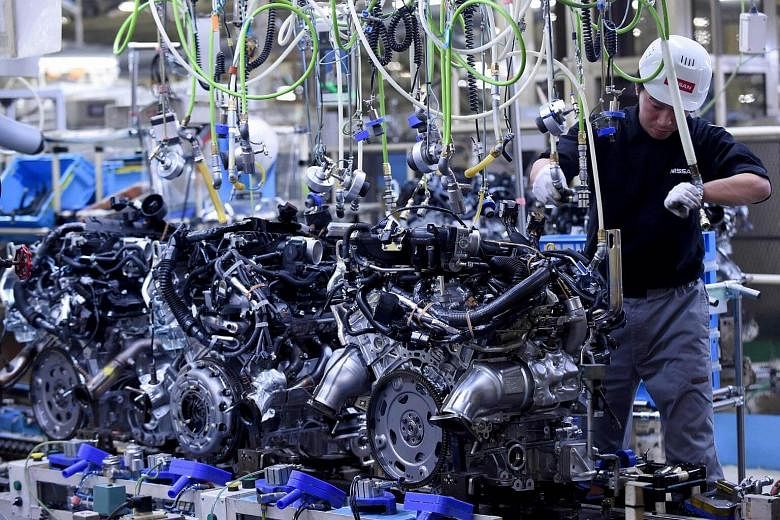TOKYO (REUTERS) - Japan's industrial output stalled in September in a worrying sign that the economy, already struggling to mount a sure-footed recovery, may be losing some momentum due to weak consumer spending and exports.
Separate data showed retail sales fell more than expected in September from a year ago, further evidence that private consumption remains a drag on growth.
Industrial output was unchanged in September from the previous month. That compares with the median estimate in a Reuters poll of a 1.0 per cent increase and followed a 1.3 per cent increase in August, data by the Ministry of Economy, Trade and Industry showed on Monday (Oct 31).
Economists say output may not pick up much in coming months. The cautious view and other data showing weak consumption and falling consumer prices could heighten expectations that the Bank of Japan will yet again push back the timing of its price target.
"I don't expect output to rise significantly for the time being," said Norio Miyagawa, senior economist at Mizuho Securities. "Domestic demand simply is not strong enough. The BOJ has sent a message that monetary policy is on hold for now. We need more effort from the private sector to increase wages."
Industrial output was flat in September as declines in semiconductor and personal computer production offset gains in autos and construction equipment.
Manufacturers surveyed by the ministry expect output to rise 1.1 per cent in October and gain 2.1 per cent in November, but their forecasts are often overly optimistic, economists say.
Overall inventories fell 0.4 per cent versus a 0.3 per cent increase in the previous month, but there were signs that high inventories in some industries could curb future output, according to Daiju Aoki, economist at UBS Securities.
Inventories of mobile phones and car navigation systems jumped 14.1 per cent, the fastest gain in six months. Inventories of construction equipment also rose 1.2 per cent in September.
In the July-September quarter, industrial output rose 1.1 percent, faster than a 0.2 per cent gain in the previous quarter, but economists say growth could moderate slightly in October-December.
Retail sales fell 1.9 per cent in September from a year earlier, slightly more than a median market forecast for a 1.8 per cent annual decline due to lower spending on apparel and daily necessities, separate data from the trade ministry showed.
That marked the seventh consecutive month of declines in retail sales, highlighting underlying weakness in the economy.
One stand out was domestic auto sales, which rose an annual 2.3 per cent in September, faster than a 2.1 year-on-year increase in August, as the BOJ's negative interest rate policy pushes down rates on car loans.
Having moved to a new policy framework that targets interest rates rather than base money only last month, the BOJ is likely to hold off on expanding stimulus at a meeting ending on Nov 1. Sources have told Reuters the central bank will cut next fiscal year's inflation forecast slightly, reflecting weak consumption and falling import costs.
The policy review may also extend the timeframe for hitting its ambitious inflation target. At present, the BOJ projects inflation to reach 2 per cent during the fiscal year ending in March 2018.

